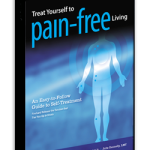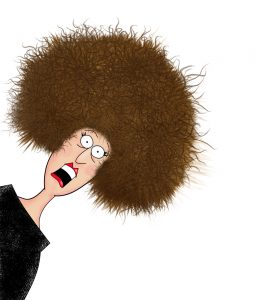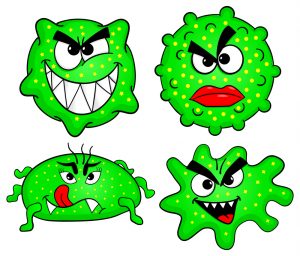“It’s Summertime, and the Living Is…Stressful”
 It’s hot out, the birds are chirping, the air is pretty still, and the rains are often torrential. It’s summer and under normal circumstances things slow down as people take vacations or just go to sit at the beach or pool. Normally, we would be singing that old favorite, “It’s summertime and the living is easy”.
It’s hot out, the birds are chirping, the air is pretty still, and the rains are often torrential. It’s summer and under normal circumstances things slow down as people take vacations or just go to sit at the beach or pool. Normally, we would be singing that old favorite, “It’s summertime and the living is easy”.
But this year is different! This summer’s song could be, “It’s summertime and the living is stressful.
We’ve all been affected by COVID19 in some manner, life is more complicated for most of us, and stress-levels have increased for a lot of people. Since stress often causes headache pain, today’s newsletter is going to focus on relieving stress headaches.
Stress Can Tighten Your Muscles
Constant stress can tie your muscles into knots. It is important to do things to relieve the stress that the current events are placing on your body. Maybe you aren’t going to the gym, but you can go out for a long, fast walk. You could even bring some light hand weights and be pumping your arms as you walk. If you have access to a pool, swimming is a great way to get exercise without stressing the body – with social distancing, of course.
There are several muscles that cause headaches. Unfortunately, it’s rare that anyone in the medical field will check out muscles while looking for the source of headache pain.
Is Stress Causing My Headaches?
As I said above, chronic stress can cause your muscles to tighten, and tight muscles can cause headaches. I will discuss two of the main offenders today.
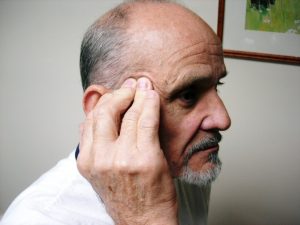 One muscle that causes headaches is called the Temporalis. This muscle is the shape of a fan and is at the temples of your skull, behind your eyes and above your ears. It not only causes headaches. It also causes pain into your top teeth!
One muscle that causes headaches is called the Temporalis. This muscle is the shape of a fan and is at the temples of your skull, behind your eyes and above your ears. It not only causes headaches. It also causes pain into your top teeth!
To treat your Temporalis muscle, take your three middle fingers and press on the muscle as shown in the picture to the left.
Find the tender point, only pressing enough to feel it, but not so much that you want to faint. Hold the pressure for a minute and then move your fingers slightly up and down, without sliding on your skin.
Release the pressure for about 15 seconds and repeat this sequence until the pain is gone.
Do this treatment on both sides of your skull. Stay still on any “hot spots” as they are the actual spasm that is causing the problem. You’ll be surprised at how the pain and tenderness will diminish as you continue to do the whole treatment for just a few minutes.
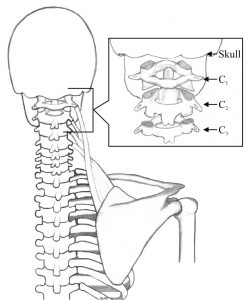 Another key headache muscle is the Levator Scapulae, a muscle that originates on your cervical vertebrae and inserts into your shoulder blade. When this muscle is in spasm it will pull your cervical vertebrae to the side and down and press the bone into your spinal cord at the base of your brain.
Another key headache muscle is the Levator Scapulae, a muscle that originates on your cervical vertebrae and inserts into your shoulder blade. When this muscle is in spasm it will pull your cervical vertebrae to the side and down and press the bone into your spinal cord at the base of your brain.
Looking at how the levator scapulae muscle attaches to the vertebrae in your neck will explain why it is an important cause of stress headaches.
The levator scapulae originates on the top four cervical vertebrae (see small box) and inserts into the top of your shoulder blade. When the muscle contracts normally you lift up your shoulders. The nickname for this muscle is “the shrug muscle” because of its action.
However, when it gets tight it will pull the insertions at your neck to the side and down. This causes the bones to press into your spinal cord, right at the base of your brain, and you get a severe headache!
Fortunately, you can treat the levator scapulae muscle, release the tension on the cervical vertebrae, and by treating the muscles in the back of your neck that become involved as the vertebrae move, you can stop the headache. It usually takes a while, maybe even two days. I wish I could tell you it’s immediate, but the important thing is you can stop the pain.
If you have suffered from headaches and your doctor has tested you to be sure it isn’t something more serious, then you’ll be pleased with the results of the Julstro™ self-treatments.
Relief From Stress Headaches Caused By A Tight Levator Scapula Muscle
Let me take you through the treatment step by step.
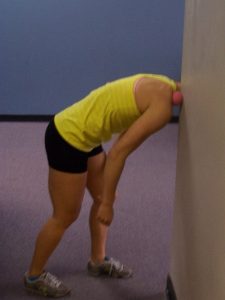 Step 1: Relaxing the Spasms in Your Shoulders
Step 1: Relaxing the Spasms in Your Shoulders
You start by relaxing the spasms in your shoulders. While it can be awkward at first, you can very effectively treat your levator scapulae muscle by using a ball and pressing into the corner of a wall.
Put the Julstro Perfect ball directly on the top of your shoulder. Then lean straight into the corner of a wall.
Move slightly until you feel the pressure being focused on the knot at the top of your shoulder.
This treatment is for both your levator scapulae muscle and your trapezius muscle.
Step 2: Treating Your Levator Scapulae Muscle.
Once you have loosened up the spasms in your shoulders, continue working on the levator scapulae muscle. You can also treat both by squeezing them with your fingers. We’ll demonstrate by treating your right shoulder. Naturally, you can do the same treatment on the opposite shoulder.
Bend your left arm and support you elbow with your right hand. Put your left three middle fingers on your right 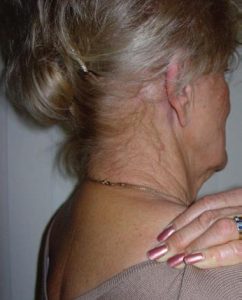 shoulder at the point where the shoulder and neck meet. It helps if you place it so your thumb and pointer finger are close to your neck with the middle finger being the working finger right on the junction, just a bit toward the back. Your four fingers should be crooked at each joint of the hand and your palm should be flat against your body.
shoulder at the point where the shoulder and neck meet. It helps if you place it so your thumb and pointer finger are close to your neck with the middle finger being the working finger right on the junction, just a bit toward the back. Your four fingers should be crooked at each joint of the hand and your palm should be flat against your body.
Staying in the same spot, relax your arm with your elbow close to the middle of your chest. In this position you will probably have your middle finger directly on the spasm point. All the strength from this move is coming from your upper arm, not from your fingers. To do that you will simply make sure that your middle finger is on the sore spot and then pull your elbow down toward the floor. Your finger will be like a hook that presses into the spasm.
If you feel your fingers getting tired, you are using your hand to give strength and not your arm. Once you feel the difference, it will be easy to do again. After you have found the trigger point and you are adding pressure to it, continue pressing into the knot.
 Next, keep your hand in the same spot, still pressing on the knot. Take your thumb, flip over onto the front of your shoulder, and push it straight into the muscle. This will move your thumb to a place that will now cause you to be pinching the knot.
Next, keep your hand in the same spot, still pressing on the knot. Take your thumb, flip over onto the front of your shoulder, and push it straight into the muscle. This will move your thumb to a place that will now cause you to be pinching the knot.
You’ll feel if you have it right. You should have a fairly thick piece of muscle between the middle finger and the thumb. You can inch your three middle fingers back a bit if you find you aren’t gripping the entire thickness of the muscle.
If all you are feeling is skin between your fingertips, go back and try again. When you know you have a thick piece of muscle, grip tightly and release. Do this four times for 15 seconds each time.
Step 3: Stretching the Muscles in Your Shoulder
Now that you have worked out the knots, you are ready to stretch your shoulder muscles. Rotate your head a bit 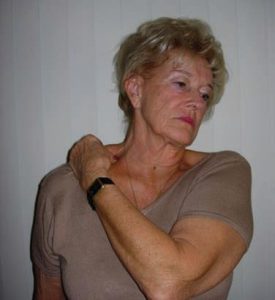 so your ear is angled toward the front of your chest. By doing this you will be adding additional stretch to the trigger point and releasing it at the same time.
so your ear is angled toward the front of your chest. By doing this you will be adding additional stretch to the trigger point and releasing it at the same time.
Finally, continue holding the muscle and move your head as shown. Hold this for 15 seconds and release the pressure. When you finish, release your grip and shake out your shoulders. Then do it again, three more times, holding each stretch for 15 seconds.
You will really feel a great deal of relief when you ease the tension in this muscle. This process will become easy after you play with it for a while and get the hang of squeezing the ball of knots that are on the top of your shoulder.
Wishing you well,
Julie Donnelly
These statements have not been evaluated by the Food and Drug Administration. This information is not intended to diagnose, treat, cure or prevent any disease.
 It’s hard to believe that the holidays are upon us, this year just flew by! I imagine we have all had ups and downs this year. COVID is still here, albeit changing form and intensity.
It’s hard to believe that the holidays are upon us, this year just flew by! I imagine we have all had ups and downs this year. COVID is still here, albeit changing form and intensity. It’s wonderful to have the holiday season before us, so many fun events to attend, time with family and friends, and delicious foods that are special for this time of year.
It’s wonderful to have the holiday season before us, so many fun events to attend, time with family and friends, and delicious foods that are special for this time of year.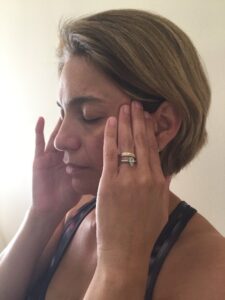 If your headache pain is in your temples, it is likely that your temporalis muscles are the culprits. The temporalis muscle is the cause of the throbbing you get in your temples when you have a headache. Fortunately, it’s easy to find, and easy to self-treat.
If your headache pain is in your temples, it is likely that your temporalis muscles are the culprits. The temporalis muscle is the cause of the throbbing you get in your temples when you have a headache. Fortunately, it’s easy to find, and easy to self-treat.

